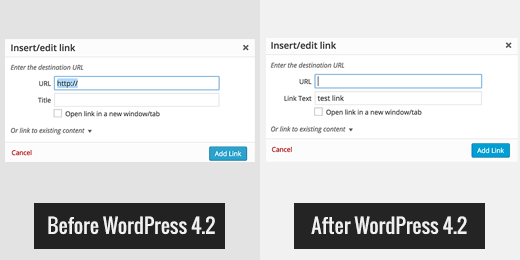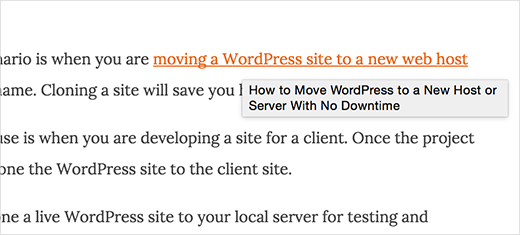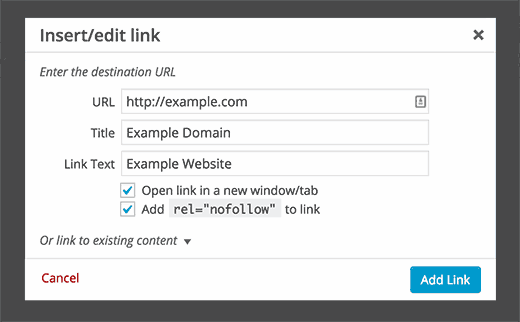En WordPress 4.2, el campo del título del enlace en la sección de insertar enlace fue reemplazado por el campo de texto del enlace. Esto fue un poco decepcionante para muchos usuarios que creen que el campo de título del enlace es útil para fines de SEO. En este artículo, le mostraremos cómo añadir el campo de título de enlace que falta en WordPress 4.2 y versiones posteriores.

¿Por qué se quitó el campo del título del enlace?
El título del enlace proporciona un título para el enlace que puede ser diferente del texto de anclaje de un enlace. Permite a los usuarios ver el título del documento enlazado. Algunos usuarios creían que tenía ventajas de accesibilidad, pero en realidad muchos lectores de pantalla no pueden leer por defecto el atributo de título en los enlaces. El mensaje / ventana emergente del título del enlace no puede ser visto por los usuarios de móviles y otros dispositivos portátiles. Estos mensajes / ventanas emergentes tampoco son visibles para los usuarios que solo utilizan el teclado.

Muchos usuarios creen que el texto del título del enlace también tiene importancia para el SEO. Permite a los propietarios de sitios utilizar títulos de documentos reales en el título, y sus palabras clave como texto de anclaje. También puede leer nuestro artículo sobre el texto alternativo de la imagen frente al título de la imagen.
Independientemente de las ventajas para el SEO o la accesibilidad, el atributo del título del enlace es ciertamente inofensivo. Aquí le mostramos cómo puede añadirlo a su sitio WordPress.
Cómo volver a añadir el campo del título del enlace en WordPress
Lo primero que tienes que hacer es instalar y activar el plugin Title and Nofollow For Links. Funciona fuera de la caja y no hay ajustes para que usted pueda configurar.
Simplemente crea una nueva entrada o edita una existente. Seleccione algún texto y haga clic en el botón de insertar enlace en el editor. Un mensaje / ventana emergente enlace de inserción aparecerá, y te darás cuenta de que el campo extra título del enlace aparece allí.

Este plugin también añade una casilla de verificación rel=”nofollow” por si quieres usarla. Lea más acerca de por qué y cuándo necesita enlazar enlaces nofollow.
Eso es todo, esperamos que este artículo te haya ayudado a añadir el título del enlace que falta en WordPress 4.2 y versiones posteriores. Puede que también quieras comprobar nuestra guía sobre cómo marcar / comprobar enlaces rotos en WordPress.
Si te ha gustado este artículo, entonces por favor suscríbete a nuestro canal de YouTube para tutoriales en vídeo de WordPress. También puedes encontrarnos en Twitter y Facebook.




Kay
This plug-in works like a charm. Thank you. I found you from a Google search after discovering the title tag was no longer available.
Christian Schnettelker
Thanks for the hint, the plugin works very well. Has been driving me nuts to add the link title manually in text view.
Cathy Miller
Yay! Thank you. This has been driving me nuts to add this manually.
Rufus B
Looks like “Kids” that have Not learned that “IF IT AIN’T BROKE, DO NOT FIX IT” are running the show here.
Trying to justify their job by irritating their clients, customers, and users.
Chris
Code manual u newbs
Mark Robinson
Or you could just edit the “alt” tag in html view and avoid clogging they system with another plugin.
Otto
You mean the “title” tag, and the plugin does nothing other than make that easier. I wrote it. I know.
Michael Maxson
A little disappointed…what an understatement! Check out the comments on the following link
https://wordpress.org/support/topic/insertedit-link-missing-title-field?replies=51
By the way, the Ottopress plugin has been working fine for me for days.
Also check out comment on WP trac at https://core.trac.wordpress.org/ticket/32095
“It’s Not A Feature…It’s A Bug. LOL
Otto
The title attribute is useless for SEO, but, I believe in choice. If somebody really wants it, then the plugin offers that choice n it’s a very simple, low-impact plugin
Serena Scholl
Thank you, Otto!! You and other WordPress peeps are AWESOME!!!The amazingness of FREE and incredible blogging / web software is … There are no words. Thank you! Thank you! Thank you!
Christian Nelson
The articles I’ve seen on this topic (including this article) give the impression that most people who liked the pre-4.2 behavior liked it for SEO and accessibility reasons.
That might be true, but I doubt that I’m the only one who liked that behavior because it let me give my readers more of a clue about what they were going to see when they clicked the link…sort of an additional confirmation of where they were heading.
What’s most irritating about this is the arrogant attitude of the WordPress developers when responding to complaints about this less-than-helpful change. Paraphrasing: “We know what’s best of you, and if you don’t like it, you know where to go.”
They’re heading for a fall.
Viktoria Michaelis
For me the link title is not quite so important, but the link itself is. So, since v4.2 I have been adding the link in by hand, through the text version, since the link command doesn’t seem to want to do what it is supposed to. But, perhaps there is a plug-in for that too….